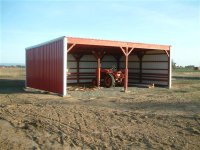we pay $3.75/bale for delivered and stacked and have maybe 100-150 at a time in place, on pallets, on a dirt floor in a barn. You can walk around the pile, used ot have it in a stall area (2 walls, was a teasing stall at one point in history so a short wall on another side). Worked well (put chickens in there over the winter).
Considering doing hay or looking at other options now that we havea tractor that can do it, can lift/stack large squares and rounds. Feed rounds in the winter -a bit wasteful but a lot less work than taking haw out to the pasture twice a day in the cold, snow and dark. No feeder, just dump them on the ground. An 800lb bale delivered is about $50.
Wha'ts nice is we can find (at auction..have to find a supplier) that does the large square bales - they come off in flakes and are about the same price and size as round bales, someteimes a big bigger for more money, but MUCH easier to stack/handle and feed.
IF we do hay a building is part of the equation to store it, figure 1000-1200 bales annual yield so a facility to hold all that. Either small rounds (under 80lb) or squares. Manhandling all that hay is a consideration. Still looking over our options.
With the price of oats of late i'm tempted to grow that instead. Older combines can be had for under $15k, or maybe I can hire the harvest out. Just started thinking on it this week as our oat supplier (a feed mill) can't get oats and we were paying $6-8/50lb and now have to go to agway/tsc/rk and pay closer to 20-21/50lb.
As a 'business' it's all abut the numbers - either it pays to do it, or not.
And too often you can end up going down the road to a place you never expected...instead of paying for snow removal and brush hogging I got us an old kubota - $1500. Very slow to brush hog so WTF, got a new Kioti for $23,000. WAY nicer, loader now too, bigger brush hog...but it's probably cheaper to pay someone to do the work..at least over a 10 year period. Nice to have control and get the job done when YOU want it done though.
Like hay and oats...we're on our third feed supplier this year...getting it deliverd, or getting it at all, is the issue. With 7 horses (some boarded) constantly fetching feed sucks.

